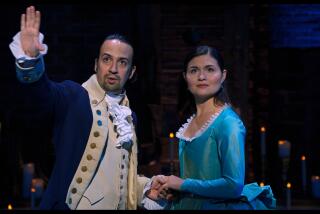Shattered
“Language is always a substitution,” writes Gary Indiana, quoting Jacques Lacan, somewhere in the pages of “Resentment: A Comedy,” Indiana’s fifth book and fourth novel, following “Rent Boy,” “Gone Tomorrow” and “Horse Crazy.” Tracing two interrelated narratives--the celebrated trial in Los Angeles of two wealthy brothers, the Martinezes, who shotgunned their parents to death, and the picaresque adventures of Seth, the gay New York reporter assigned to cover their story for a glossy monthly--Indiana has looked straight into the face of the tabloid world, a nonculture of vulgarity, public spectacle and murder set mainly in a Los Angeles even loonier than that of Nathanael West’s and, choosing the Lacanian option, decided to pick up his pen.
Regarding the shotgun murder: In spite of a coy author’s note to the contrary, it is the Menendez spectacle on which Indiana is almost fixatedly word perfect, but fictive names allow him all sorts of narrative and speculative fancies. He revealingly writes, as no doubt he imaginatively believes, that, as a way to record it, “you could turn it into a Mardi Gras float or a tableau vivant in a wax museum, serialize it into Stations of the Cross, fashion it into topiary or embroider it on exotic underpants.” Obviously, Indiana, like his character Seth, “believes it is always better for something to happen than for nothing to happen,” and this long, open-ended “black comedy”--a book far, far too long--proves it.
The criminal energy that fixes as the central story the famously ballyhooed murder and public trial of two murdering brothers, Carlos and Felix Martinez, also fascinates not only Seth, who is a true outsider in many ways, both socially and psychologically (“he keeps hearing words in his head ending in ‘ix’ like ‘creatrix,’ ‘dominatrix,’ ‘aviatrix’ ”), but a whole consortium of satellite characters, stick figures almost to a one: JD, a gay taxi driver with AIDS; Morgan, a New Age lesbian; Janice, a stalking victim and her movie star husband, Teddy; and scads of other gays, Frankie, Billy, Bobby, Jack, etc., most of whom, with no last names, are far too poorly realized to be seen as anything like multidimensional characters. They join the crazy, cackhanded world of C-list actors, freeway shooters, corrupt judges, fat detectives, movie trivia buffs, shiatsu therapists, drug addicts, cyber-sickos, pornocrats, catamites, quacking lawyers, reporters and idiolects of the midnight phone call. Does this sound like plenitude? It is not. These are not characters. It is a population.
What Indiana tries to do to drive the book is to keep cutting away from the public trial to rehearse various events in the lives of his marginals, most if not all of which seem to be homosexual dalliances, far too Victorian a word for what in most such scenes is lubriciously (and artlessly) described. What does take my attention is Indiana’s thorough grasp of so many facts and details of the Menendez crime. I myself had, and have, only a general knowledge of the case; but finding disingenuous--or is it humility?--the author’s willingness to admit to anything but a “superficial resemblance” to it, I decided upon picking up the book to look for the one ghastly detail which, since 1989, had always vividly stuck in my mind. Sure enough, it appears on Page 192.
After 10 blasts of the shotgun, Carlos said that “someone” was still moving.
“Who was this someone, Marlene Quilty [Carlos’s defense attorney] demanded. My mother, Carlos admitted. What was your mother doing? In my mind, Carlos said, she was sneaking around the side of the couch.”
Indiana passed my test.
It was obviously always Indiana’s creative ambition, along with tracking the horror and lunacies of the Martinez trial to give us a sort of updated “Garden of Earthly Delights,” a crazy Boschian sub-landscape peopled with inexorable crazies, of Los Angeles unhinged. Pages are filled with references to Charlie Manson, the Nixon of Watergate, the Simpson trial, Richard Ramirez, John Wayne Bobbitt, along with and including the notorious Black Dahlia case, about which Indiana seems to be extraordinarily familiar, and the fires burning in Malibu Canyon. Just as the vast, undefined city leaves people strangely lacking a sense of place, these displaced people begin to feel resentment, and the “comedy” grows out of the black misery that public obsession with the criminal zeitgeist is not unaligned to one’s own personal pathology.
The book is filled with allusion and color. Indiana writes well. He describes a woman “with hair ratted up like the high note of a show tune.” There is a rather remarkable 25-page stream of consciousness passage in which Felix is being grilled on the witness stand. A good deal of fussification is given to food descriptions, which are oddly fascinating, and Indiana offers a lot of funny gossip.
Scenes, however, are too often unintegrated, and one can rarely care about the vicissitudes of characters in a book in which the author is determined to offer little more than their sexual fancies and foibles. Characters, who tend to be only bodies, can’t even be said to have faces. The idea I suspect we are to have, not only at the end but all along--that events outside the courtroom inexorably come to mirror the crime being tried inside--is a bit too bogus to fly, and if it is true that language is always a substitution, one may add that it is not always a successful one.
More to Read
Sign up for our Book Club newsletter
Get the latest news, events and more from the Los Angeles Times Book Club, and help us get L.A. reading and talking.
You may occasionally receive promotional content from the Los Angeles Times.






